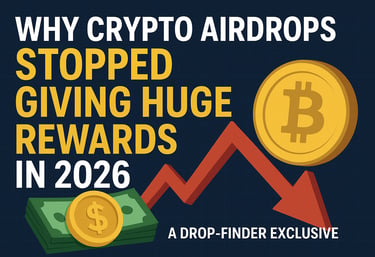Why Crypto Airdrops Stopped Giving Huge Rewards in 2026 – DropFinder Exclusive Insight
Once the golden ticket to free crypto wealth, airdrops in 2026 have dramatically changed. What used to deliver thousands of dollars to early users now barely covers gas fees. In this in-depth DropFinder analysis, we explore why crypto projects have scaled down airdrop rewards, how the ecosystem evolved, and what the future holds for real airdrop hunters.
LATEST AIRDROP
10/24/20256 min read
Introduction: The Golden Age of Airdrops Is Over
Between 2020 and 2023, crypto airdrops were legendary. Early adopters of Uniswap, Arbitrum, Optimism, and Blur received massive token rewards worth thousands — sometimes even tens of thousands — of dollars. Airdrops were seen as the perfect marketing tool: users tried new platforms, spread the word, and were rewarded handsomely.
Fast forward to 2026, and the landscape looks completely different. Despite the crypto market being larger than ever, airdrops are shrinking — both in size and value. While once you could earn $5,000 from a single campaign, today’s average airdrop often nets less than $20.
Platforms like DropFinder, which specialize in tracking verified and legitimate airdrops, have noticed a sharp decline in massive reward events. The question is — why did this happen?
Let’s dive into the 2026 reality of the airdrop ecosystem.
1. The Era of Airdrop Farming and Bots
The first and most obvious reason huge airdrops have disappeared is airdrop farming. Once people realized how profitable airdrops could be, they began exploiting them using multiple wallets and scripts.
By 2024–2025, automated bots were creating thousands of fake wallets, interacting with dApps, and mimicking real users to claim future airdrops. This made it almost impossible for projects to reward genuine community members.
When protocols like zkSync, Starknet, and LayerZero launched, millions of sybil wallets were detected — forcing teams to blacklist them or drastically reduce individual rewards.
In short, what was meant to be a reward for real users became a bot battlefield.
DropFinder reported that by early 2026, over 60% of major airdrop campaigns were targeted by bots, leading projects to switch to smaller, more selective reward systems.
2. Budget Constraints and Market Realities
During the bull run, projects were flush with venture capital and high token valuations. Distributing millions in airdrops didn’t feel like a big deal because token prices were soaring.
But as markets matured, venture funds tightened their wallets. In 2026, many projects operate leaner — prioritizing sustainability over hype.
Instead of giving away $100 million in tokens, they now focus on community grants, partnerships, and smaller incentives that reward engagement over speculation.
Crypto startups now treat tokens as equity, not marketing fuel. Free giveaways don’t fit into long-term sustainability models anymore.
3. Airdrop Hunters vs. Real Users
Airdrops were originally designed to reward early adopters — the users who genuinely tested and improved platforms. But the rise of “airdrop hunters” changed that dynamic.
Entire online communities formed around gaming the system — completing minimum requirements without ever using the platform meaningfully.
Developers quickly realized most airdrop participants never became loyal users. They just dumped tokens immediately, hurting price stability and project reputation.
Projects like Arbitrum and Optimism experienced this firsthand — after distribution, token prices fell sharply as thousands rushed to sell.
To counter this, teams in 2026 use “proof-of-use” models — tracking on-chain behavior over time, rather than simple one-time interactions.
DropFinder now tracks such criteria in its listings, showing whether airdrops favor engaged users or short-term claimers, helping genuine participants focus their efforts wisely.
4. The Evolution of Tokenomics
Tokenomics has matured drastically since the early days of airdrops. In 2026, most projects carefully plan their supply distribution — balancing community incentives, liquidity, staking, and team reserves.
Massive airdrops once caused chaotic market dilution. Early token holders dumped for instant profit, destroying token value. Now, teams distribute tokens gradually, sometimes locking them for months or years to stabilize circulation.
For example, instead of giving 10% of total supply in one go, projects might:
Airdrop 2% to verified users
Allocate 3% to community staking
Reserve 5% for long-term growth programs
This measured approach ensures sustainability — but it also means fewer instant windfalls for users.
DropFinder’s tokenomics analysis section highlights how project reward structures have shifted from “airdrop-heavy” to balanced ecosystem incentives.
5. Regulatory Pressure on Free Token Distribution
Governments worldwide have become more cautious about “free crypto” programs. Many regulators view airdrops as potential unregistered securities offerings or taxable income.
In the U.S., U.K., and parts of Asia, authorities now require clearer disclosures and compliance checks before distributing tokens publicly.
This makes large-scale airdrops legally risky. Projects now prefer controlled launches or NFT-based participation models that comply with financial regulations.
In 2026, some projects even require KYC (Know Your Customer) before claiming — drastically reducing participation numbers and eliminating anonymous multi-wallet farming.
6. Shift Toward Loyalty and Community Programs
Instead of one-time airdrops, projects now build ongoing engagement programs. These reward users for activity, referrals, staking, and long-term participation rather than a single claim event.
Platforms like Friend.Tech 2.0 and DeFi Kingdoms use tiered loyalty systems where users earn gradually over time — similar to credit card rewards.
While this ensures fairer distribution, it eliminates the huge lump-sum drops of the past.
DropFinder tracks these new “Earn-as-you-go” campaigns, helping users find sustainable earning opportunities instead of short-lived token grabs.
7. Layer-2 Overcrowding and Reduced Exclusivity
In 2021–2023, airdrops were tied to pioneering protocols — Ethereum, Solana, Avalanche, and the first Layer-2s like Arbitrum. Those who joined early reaped massive rewards because they were part of a small, elite group of early testers.
By 2026, however, everyone is an early user somewhere. Thousands of Layer-2 and Layer-3 projects launch each year, each offering small airdrops.
The exclusivity that made early rewards special is gone.
What was once a rare event is now oversaturated. DropFinder’s airdrop database reflects this — while listings have tripled in number since 2023, the average per-user reward size has dropped by 90%.
8. AI and Smart Filtering of Participants
AI technology is now widely used by blockchain teams to filter fake users and identify real participants. Machine learning models analyze user behavior — number of wallets, transaction diversity, time gaps, and interaction quality — to detect sybil activity.
As a result, mass claimers and script-based farmers are often excluded automatically.
While this creates fairness, it also limits how many people can qualify — leading to fewer eligible winners and smaller payouts per user.
DropFinder has integrated AI-based authenticity scoring into its listings, giving users transparency on how strict each campaign’s criteria are.
9. Market Maturity and Lower Hype Levels
Crypto in 2026 is no longer the wild west it was a few years ago. The market has matured, and users are more cautious.
Projects don’t need to hand out millions to attract attention anymore — good tech, strong communities, and transparent teams now generate trust organically.
Massive airdrops have simply lost their marketing power. Instead, targeted micro-rewards and NFT-based access tokens are the new trend.
10. Token Value Management
Early projects often underestimated how damaging a large airdrop can be to token value. When thousands of people instantly sell, it destroys price stability.
Newer teams now adopt progressive vesting or task-based unlocking, ensuring that tokens are earned over time rather than dumped instantly.
For example:
Users receive 10% on claim, then unlock the rest over 6 months.
Others must perform tasks like staking, governance voting, or liquidity provision to unlock more.
These models make projects more stable but eliminate huge instant profits.
DropFinder’s reports show this trend accelerating — 80% of 2026’s major airdrops use vesting or milestone-based unlocking.
11. The Rise of Real Utility Over Speculation
The crypto industry is shifting from speculative hype to real-world utility — gaming, finance, supply chains, and tokenized assets.
Teams prefer building sustainable ecosystems rather than spending their token reserves on flashy giveaways.
Many now use reputation-based airdrops, rewarding users for actual contributions — bug reports, content creation, governance participation — rather than random transactions.
This ensures that value flows to real contributors instead of passive farmers.
DropFinder’s “Utility Airdrop” filter helps users identify such genuine reward systems, distinguishing them from low-value promotional drops.
12. The End of Retroactive Surprise Drops
One of the most exciting parts of early airdrops was the surprise. Users who interacted with protocols months earlier suddenly woke up to thousands in tokens.
But those days are over. Retroactive airdrops have become predictable and exploitable.
Farmers now flood every testnet, every beta dApp, every faucet — just in case a future snapshot happens. This forces teams to either skip retroactive models or keep them minimal.
In 2026, most projects pre-announce drops and set strict eligibility rules, removing the element of surprise.
13. Layer-3 and Cross-Chain Complexity
With multi-chain ecosystems expanding, tracking user activity across networks has become more complicated.
Distributing tokens fairly across multiple chains (like Ethereum, Base, and zkSync) is a logistical nightmare — with higher gas costs, duplicate users, and bridging exploits.
To simplify, teams now conduct smaller, chain-specific airdrops instead of huge, global ones.
DropFinder helps users navigate this complexity by categorizing airdrops by chain, showing claim processes and gas requirements clearly.
14. Overwhelming Competition for Limited Tokens
In 2026, every crypto user is aware of airdrops. Platforms that once had 10,000 users now see millions.
Even if a project allocates the same total reward pool, each individual gets a smaller share.
It’s simple math:
2020: 10,000 users share 10 million tokens = 1,000 each
2026: 2 million users share 10 million tokens = 5 each
The rewards didn’t shrink — the competition exploded.
DropFinder’s user trend data confirms this massive participation surge across all major campaigns.
15. The Future: Quality Over Quantity
While huge windfalls are fading, better-designed airdrops are emerging.
Projects now prioritize:
Verified community participation
Long-term engagement
Cross-platform loyalty
Educational and governance contributions
In other words, the free-money era is ending — but a smarter, more ethical system is being born.
DropFinder continues to evolve with this change, ensuring users don’t chase dead ends but instead discover real, rewarding opportunities.
Conclusion: The Evolution Was Inevitable
Crypto airdrops didn’t stop being generous by accident — they evolved.
From wild giveaways to targeted engagement systems, the space matured. Massive token drops attracted bots, dumped prices, and drained treasury funds. Developers learned their lesson.
Now, 2026 is the age of smart distribution, where rewards go to those who truly support and contribute to projects.
As the market continues to grow, tools like DropFinder are more crucial than ever — helping genuine crypto enthusiasts navigate an increasingly complex, data-driven ecosystem.
The golden era of massive airdrops may be over, but the era of meaningful rewards has just begun.
Final Line:
DropFinder – Discover Smarter, Earn Fairer, and Stay Ahead in the New Age of Airdrops.




